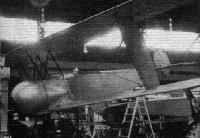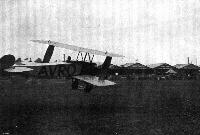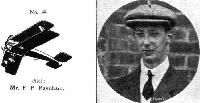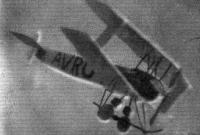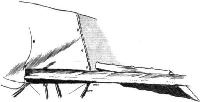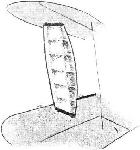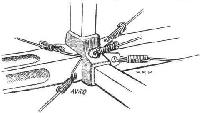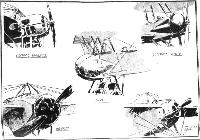A.Jackson Avro Aircraft since 1908 (Putnam)
Avro 511
Three full-sized aircraft shown on the Avro stand at the Olympia Aero Show, London, March 16-25, 1914, were a production Avro 504 seaplane, the Avro 508 pusher and the Avro 511 single-seat, single-bay biplane. This was designed specifically for fast scouting in the event of war and could be swiftly dismantled for road transport to the operational area. Heavily staggered, sparless mainplanes of cellular construction, designed and stressed by Avro’s assistant designer H. E. Broadsmith, were given pronounced sweepback in an attempt to reduce the span and attain inherent stability. On this account the aircraft was promptly and unofficially dubbed ‘Arrowplane’ or even ‘Arrowscout’ by the sensational press but these names can find no place in a serious work of reference. Ailerons were fitted to all four wings and single wide-chord interplane struts were used on each side. Landing flaps were incorporated in the inboard trailing edges of the lower mainplanes and pivoted diagonally about a stout steel tube which passed through the fuselage. This device, years ahead of its time, reduced touchdown speed to 35 mph.
The Avro 511 was otherwise typically Avro with standard centre-skid undercarriage and comma-type rudder. The nose was of good streamline shape with a close fitting cowling round the 80 hp Gnome Monosoupape rotary engine. The cowling was later modified as it prevented adequate cooling. Estimated maximum speed was 95-100 mph and the machine was to have been piloted by F. P. Raynham in the Aerial Derby Race round London on May 23, 1914 (racing No. 14). Storms on the eve of the race caused deterioration in the weather which led to a postponement until June 6 but Raynham managed to make one or two demonstration runs for the benefit of the few hardy spectators. When returning home on the following day he made a safe landing after the engine failed within gliding distance of Brooklands. It had not proved as fast as had been hoped but was nevertheless entered (racing No.20) in the postponed Aerial Derby.
In preparation for this event the Avro 511 was fitted with alternative mainplanes without sweepback which Broadsmith had designed in case trouble was encountered with the swept wings. The rebuilt machine, designated Avro 514, was also equipped with a light weight, unsprung, V-type racing undercarriage without the familiar skid, but while taxying out at Brooklands to take off for Hendon on the eve of the race, an eye bolt sheared. The undercarriage collapsed, breaking the airscrew and bending the engine crankshaft as well as damaging wings and fuselage. After reconstruction at Manchester the Avro 514 was successfully flown from Southport Sands by F. P. Raynham in July 1914 but further development was ended by the outbreak of war.
SPECIFICATION AND DATA
Manufacturers: A. V. Roe and Co. Ltd., Clifton Street, Miles Platting, Manchester; and Brooklands Aerodrome, Byfleet, Surrey
Power Plant: One 80 h.p. Gnome Monosoupape
Dimensions:
Span 26 ft. 0 in. Length 22 ft. 4 in.
Height 9 ft. 4 in. Wing area 235 sq. ft.
Weights: Tare weight 675 lb. All-up weight 1,165 lb.
Performance: Maximum speed 95-100 m.p.h.
Показать полностью
M.Goodall, A.Tagg British Aircraft before the Great War (Schiffer)
Deleted by request of (c)Schiffer Publishing
AVRO Type 511 'Arrowscout'
This single-seat scout biplane made its first appearance at the Olympia Aero Show of March 1914. It flew for the first time at Brooklands shortly before the Aerial Derby of May 23, for which it carried racing number 14. The contest was postponed due to poor weather, but Raynham flew to Hendon from Brooklands and demonstrated the aircraft. The race was flown on 6 June, but the 'Arrowscout' was by this time modified to become the Type 514, with alternative wings and other changes to improve its disappointing performance.
The swept wings, a new departure, introduced design problems and justified the manufacture of the alternative straight wings as a safeguard. Another new feature was the fitting of air brakes, which formed the inboard sections of the lower wings, to reduce the landing speed.
Power: 80hp Gnome Monosoupape seven-cylinder air-cooled rotary.
Data
Span 26ft
Chord 6ft 6in
Gap 5ft 3in
Area 236 sq ft
Length 22ft 9in
Weight 675 lb
Weight allup 1,165 1b
Max speed 95-100 mph
AVRO Type 512
A projected land-plane with one 65hp Austro-Daimler engine.
Span 26ft.
AVRO Type 514
The main changes to the Type 511, to improve its performance, were to replace the wings with unswept units with conventional interplane struts and to redesign the undercarriage, which was an unsprung vee type and without the central skid. The aircraft was entered as No.20 in the postponed Aerial Derby, but its undercarriage failed on takeoff at Brooklands, before the event.
Although the 514 was repaired at Manchester and flown by Raynham at Southport in July, no further development took place.
AVRO Type 515
This was a September 1914 design for a biplane with a 150hp Sunbeam engine.
Показать полностью
P.Lewis British Aircraft 1809-1914 (Putnam)
Avro 511 Arrowscout
During the year before the start of the 1914-18 conflict the idea of a specialized type for use as a fast scout in war had taken firm root in the minds of several designers, among them A. V. Roe, who had by this time given up most of his active flying and was concentrating upon design. His thoughts upon the subject appeared in the form of the Arrowscout, the new machine being shown on the Avro stand at the 1914 Olympia Aero Show, where it was seen to embody a number of original and advanced ideas.
A single-bay biplane layout was adopted, considerable sweep-back being used on the wings, the lower surfaces of which were flat. Slight dihedral was incorporated, and the upper and lower wings were connected by single, close-set pairs of light-weight interplane struts which were faired between with fabric to form "I" struts. "N" centre-section struts formed the rest of the wing-supporting structure. Another unusual feature was the lifting of air-brakes at the lower rear wing roots, consisting of rectangular trailing-edge surfaces which were hinged at their centre lines to stand vertically across the airflow, the Arrowscout thus qualifying as one of the earliest aeroplanes to be fitted with them, lateral control was provided by cable-connected ailerons on all four wing-tips. The rest of the airframe was strongly reminiscent of the 504 on a reduced scale. Power was provided by an 80 h.p. Gnome mounted within a cowling which proved to be too closely fitted for adequate cooling. Yet another feature of the 511 was the Avro system of unit construction which conferred quick dismantling and re-erection within a few minutes. The pilot also had the benefit of the Avro Safety-belt.
After two flights the Arrowscout made its first flying appearance in public at Hendon on 23rd May, 1914, with Freddy Raynham in the cockpit. After its first flights, modifications were made to the machine in preparation for the 1914 Third Aerial Derby. Straight, instead of swept-back, wings were fitted and the sturdy original undercarriage was replaced by a light-weight streamlined arrangement without springing. This was, not surprisingly, unequal to the task and collapsed when Raynham was testing the Arrowscout at Brooklands the day before the race, inevitably resulting in its withdrawal from the contest.
SPECIFICATION
Description: Single-seat tractor biplane. Wooden structure, fabric covered.
Manufacturers: A. V. Roe & Co. Ltd., Clifton Street, Miles Platting, Manchester.
Power Plant: 80 h.p. Gnome.
Dimensions: Span, 26 ft. Length, 22 ft. 9 ins. Wing area, 236 sq. ft.
Weights: Empty, 675 lb. Loaded, 1,165 lb.
Performance: Maximum speed, 100 m.p.h. Landing speed, 40 m.p.h.
Показать полностью
H.King Armament of British Aircraft (Putnam)
519. Though evidently intended for military use, the intended functions of this 1916 biplane two-seater cannot be determined. Defensive armament could not have been employed effectively because of fuselage form, but it may be significant that the Avro company have mentioned 'several large single-engined bombers' built by them before March 1916.
Показать полностью
P.Lewis The British Fighter since 1912 (Putnam)
Tempted also by the idea of the small scout, A. V. Roe showed their conception in the Type 511 Arrowscout, in reality a scaled-down 504 with single-bay sweptback wings and an 80 h.p. Gnome. The machine was tested by F. P. Raynham and turned in a top speed of 100 m.p.h. but made no further progress. One of its advanced features was the incorporation of airbrakes in the lower wing roots, an early example of their use.
Показать полностью
F.Mason The British Fighter since 1912 (Putnam)
Avro Type 511 Arrowscout
Displaying numerous obvious Avro design characteristics, the Avro Type 511 was one of three aeroplanes displayed by the company at the Olympia Aero Show in March 1914. It was a small aircraft designed to undertake fast scouting duties in the event of war, and for this reason the Type 511 gained its unofficial name of Arrowscout.
Designed by H E Broadsmith, the company’s assistant designer, the 511 featured staggered, swept-back wings with single broad-chord interplane struts. Power was provided by an 80hp Gnome monosoupape in a close-fitting circular cowling and was intended to bestow a top speed of between 95 and 100mph, but this was not achieved in practice. At the other end of the scale, the landing speed of 35mph was achieved by the use of two small interconnected flaps under the lower wings - an innovation whose efficiency was demonstrated many years before it was almost universally adopted. In other respects - the compound-circular balanced rudder without fin, ailerons on upper and lower wings and landing wheels with central skid - the 511 was unremarkable.
The Type 511 is believed to have been first flown by Fred Raynham during April 1914, but little further flying was done before the swept wings were replaced by unswept surfaces and the aircraft re-designated the Type 514; in this form it was first flown by Raynham during July. With the outbreak of war in the following month work on the aircraft was discontinued.
Type: Single-engine, single-seat single-bay scout biplane.
Manufacturer: A V Roe & Co Ltd, Clifton Street, Miles Platting, Manchester; and Brooklands Aerodrome, Byfleet, Surrey.
Powerplant: One 80hp Gnome monosoupape seven-cylinder rotary engine.
Structure: Box-girder fuselage with four ash longerons with spruce cross struts; sparless swept wings of cellular construction. All fabric covered.
Dimensions: Span, 26ft 0in; length, 22ft 4in; height, 9ft 4in; wing area, 235 sq ft.
Weights: Tare, 675lb; all-up, 1,165lb.
Performance: Max. speed, about 90mph; landing speed, 35mph.
Armament: None fitted
Prototype: One (first flight, probably April 1914). No production.
Показать полностью
Журнал Flight
Flight, March 14, 1914.
WHAT THERE WILL BE TO SEE AT OLYMPIA.
THE EXHIBITS.
Avro (A. V. Roe and Co.). (64.),
THIS well-known firm will exhibit three machines, all of which are fitted with 80 h.p. Gnome engines - a tractor hydro-aeroplane, a fighting biplane, and a scout tractor.
<...>
The "tabloid" single-seater scout, the latest production of Messrs. Roe, embodies several novel features, and is an excellent example of modern high-efficiency design, as is evident from the remarkably wide speed variation which is claimed for it. The wings are set back at the tips, so as to enhance the stability of the machine, while the unique system of bracing employed enables a number of wires (which are anchored in such a manner that no matter how the centre of pressure upon the wings may move, the loads are taken by both spars) to be dispensed with, thereby reducing the head resistance to some extent. This machine is fitted with air brakes, and, it is stated, may be dismantled and re-erected in a few minutes. The landing chassis is similar in construction to that on the 80 h.p. tractor land machine. The engine is an 80 h.p. "monosoupape" Gnome.
Each of the above machines will be fitted with the Avro safety belt, concerning which there is ample evidence of the fact that it has been designed by a practical man. Its notable features are, that the aviator gets into and out of the belt by means of the quick-release devices, which are in duplicate - one on each side - thereby ensuring that it is in working order, and the ample depth of the front section of the belt, which precludes any possibility of internal injury resulting should the pilot be suddenly thrown forward.
Flight, March 21, 1914.
THE OLYMPIA EXHIBITION.
THE EXHIBITS.
AVRO (A. V. ROE AND CO.). (64.)
THREE machines of different types, all representing considerable departures in design from previous models, whilst at the same time retaining the good qualities that have established such an enviable reputation for this enterprising firm. Keenly alive to the various requirements of the Army and Navy, Mr. A. V. Roe has designed three entirely different types, each for a different purpose, one being a military biplane of the pusher type, and built with a view to meeting the demand for a machine affording the observer an unrestricted view, and also possessing facilities for the mounting of a gun if desired. The second machine is a small, fast, single-seater, designed for scouting purposes, whilst the third and last is a hydro-biplane. All three machines are fitted with 80 h.p. Gnome engines.
<...>
Of the remaining two machines on this stand.
The 80 h.p. Single-seater Scout is perhaps the more interesting since it embodies so many novel features. The chassis, fuselage and tail planes of this biplane follows standard Avro practice throughout, and are similar in every way to those of the tractor biplane described in FLIGHT for December 6th last. It is mainly in the design of the wings and their bracing that this machine is remarkable.
The wings have a very pronounced backward slope so as to increase the stability, which latter is further enhanced by the usual dihedral angle. In section the planes are remarkable, in that they are absolutely flat on the under surface, whilst the upper surface is cambered in the usual way. This wing section is apparently one of the important factors for the very high speeds claimed for the machine, one of the others being the reduction of head resistance in the wing bracing. Only one pair of struts on each side separate the main planes, and a streamline casing around these struts further reduces the head resistance to that of a single strut on each side. The wing bracing is effected by two stranded cables running from the top and bottom respectively of the fuselage struts to a steel tube connecting the main spars at the point where these join the struts. Thus when the centre of pressure travels backwards and forwards, the load is always taken by both spars through the intermediary of the steel tube connecting them. Ailerons are hinged to the outer trailing edges of both planes, whilst air brakes for pulling the machine up quickly on landing are formed by pivoting the rear portion of the wing near the body. For checking the speed of the machine on alighting the pilot turns these air brakes by means of a lever until they are broadside on with regard to the line of flight.
<...>
Common to all the three machines is an extremely neat instrument board of Avro design, comprising altimeter, clock, compass, air speed indicator and revolution indicator, and all the machines are furthermore fitted with the Avro safety belt, the design of which is already known to the majority of our readers.
Flight, May 22, 1914.
THE AERIAL DERBY.
THE PILOTS AND HOW TO RECOGNISE THE MACHINES.
No. 14. The 80 h.p. Avro Scout.
This machine will be easily recognized from the shape of its wings, which slope backwards so as to form a V.
THE MACHINES AND HOW TO RECOGNISE THEM.
No. 14. The 80 h.p. Avro Scouting Biplane was, it will be remembered, exhibited at the last Olympia Aero Show. It is mainly characteristic on account of its main planes, which slope backwards so as to form a V, as seen in plan. This machine, which was fitted at the time of the Show with air-brakes for the purpose of reducing the speed when landing, is expected to be very fast, as the angle of incidence is very small and the planes are perfectly flat on the under sutface.
Flight, June 12, 1914.
THE 80 H.P. AVRO SCOUT.
THE subject of our scale drawings this week - the 80 h.p. Avro Scout - made its first public appearance at Hendon on May 23rd last, piloted by Mr. F. P. Raynham. This machine had, we understand, only been tested on two short flights previously, so that, in view of the fact that she presents such considerable departures from standard design, her performances were very good indeed. From Mr. A. V. Roe we learn that the machine was not quite so fast as he had expected, but this was probably partly due to the fact that the engine was not running particularly well. As far as one was able to judge, the speed range was very considerable, and without knowing actual figures we should think that the maximum speed was over 90 m.p.h. The climbing capabilities also seemed very good indeed, Mr. Raynham taking the machine up at what looked like an alarmingly steep angle, but which was in reality probably about 30#.
Constructionally, this machine differs little, at least as regards the fuselage, from standard Avro practice. It is mainly in the design and construction of the wings that innovations are to be found. Most noticeable among these is the way in which the main planes slope backwards so as to form a V as seen in plan. Only one pair of struts on each side separate the main planes, and these struts are cross-braced and covered in with fabric to form a unit, thereby reducing head resistance to that of a single strut. The wing bracing has been reduced to an absolute minimum since only one pair of cables on each side provide the necessary rigidity. At their outer ends these cables are attached, by means of a steel clip, to a steel tube of two inches diameter, built into the wing and joining the two spars. Thus, for any position of the centre of pressure the lift is always taken by both spars through the intermediary of the steel tube.
In section the wings are somewhat unusual in that they are perfectly flat on the under surface, whilst the top surface is cambered in the usual way. In addition to the backward slope of the wings, these are set at a very pronounced dihedral angle in order to increase lateral stability. Ailerons are fitted to both upper and lower planes, but the air brakes with which this machine was fitted at the Olympia Aero Show have been temporarily rendered immovable by securing them to the rear spar with an aluminium strip, probably owing to the fact that there has not yet been time for experiments with the action of these brakes.
The engine, an 80 h.p. Gnome, is mounted between double bearings, and is almost totally enclosed by an aluminium shield. Some trouble was experienced in keeping the engine cool so that it is possible that a few alterations will be effected in order to provide more efficient cooling. The chassis is of the usual Avro type, and appears to possess an enormous amount of flexibility. The fuselage, as has been already said, differs but little from those of the larger Avro biplanes. The four ash longerons are strengthened by triangular pieces of three-ply wood tacked on. The pilot is accommodated in a very comfortable bucket seat, and has in front of him a neat set of instruments mounted on an Avro instrument board. Control is by means of a single central column mounted on a transverse rocking shaft, which carries crank-levers for the elevator. The rudder is operated by a pivoted foot-bar in the usual fashion. Mounted on the rear-end of the fuselage are the tail planes, which are of the usual Avro type, consisting of a fixed tail plane, to the trailing edge of which is hinged a divided elevator, and a balanced rudder. A small laminated steel skid protects the tail planes against contact with the ground.
It is difficult at the present juncture to express an opinion as to the merits or otherwise of this machine, but judging from her behaviour during her first flight in public, and considering the few tests that have been made with her up to now, she must be said to be very promising, and Messrs. A. V. Roe and Co. are to be heartily congratulated on their continued determination to introduce new departures in design.
Показать полностью







